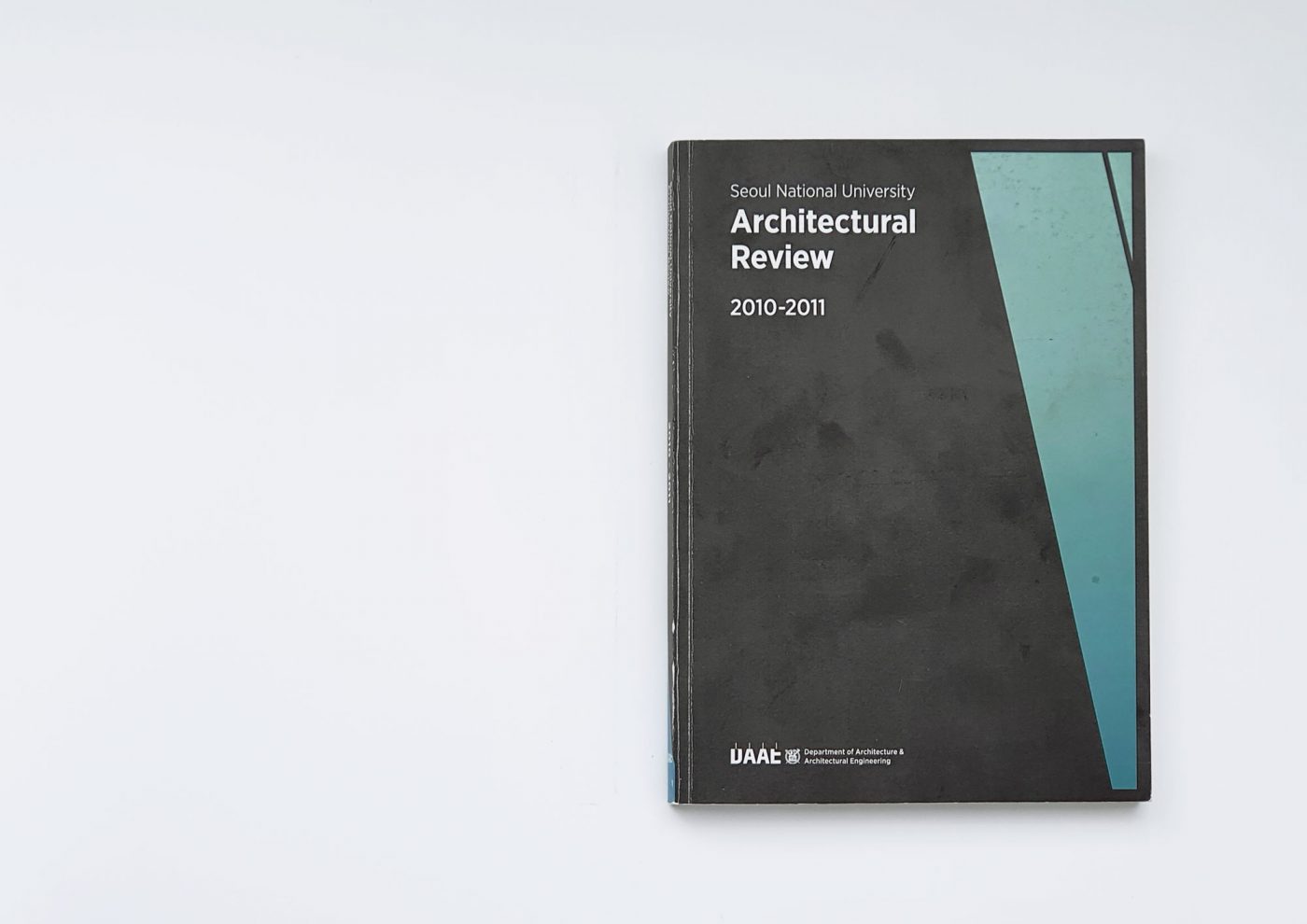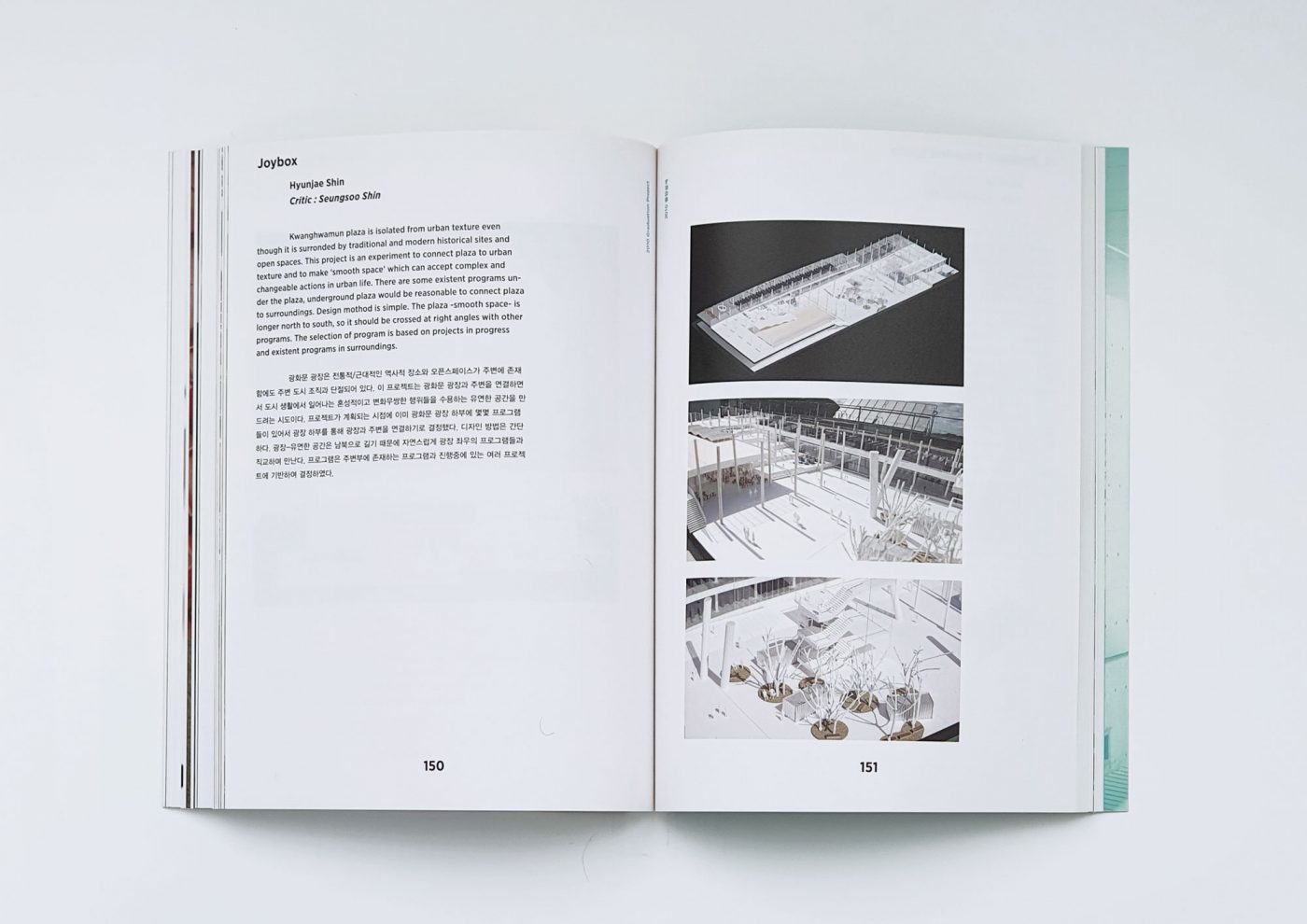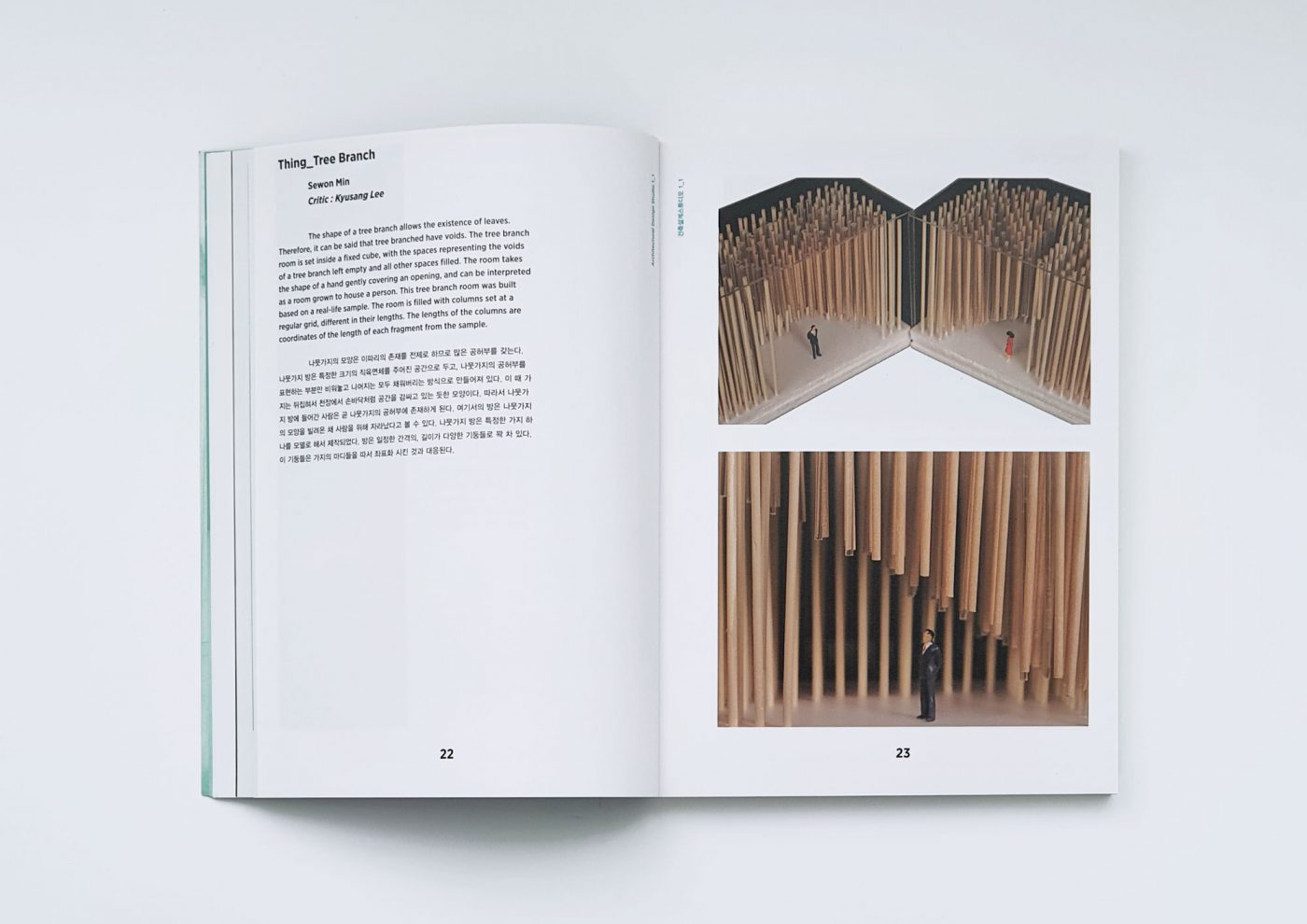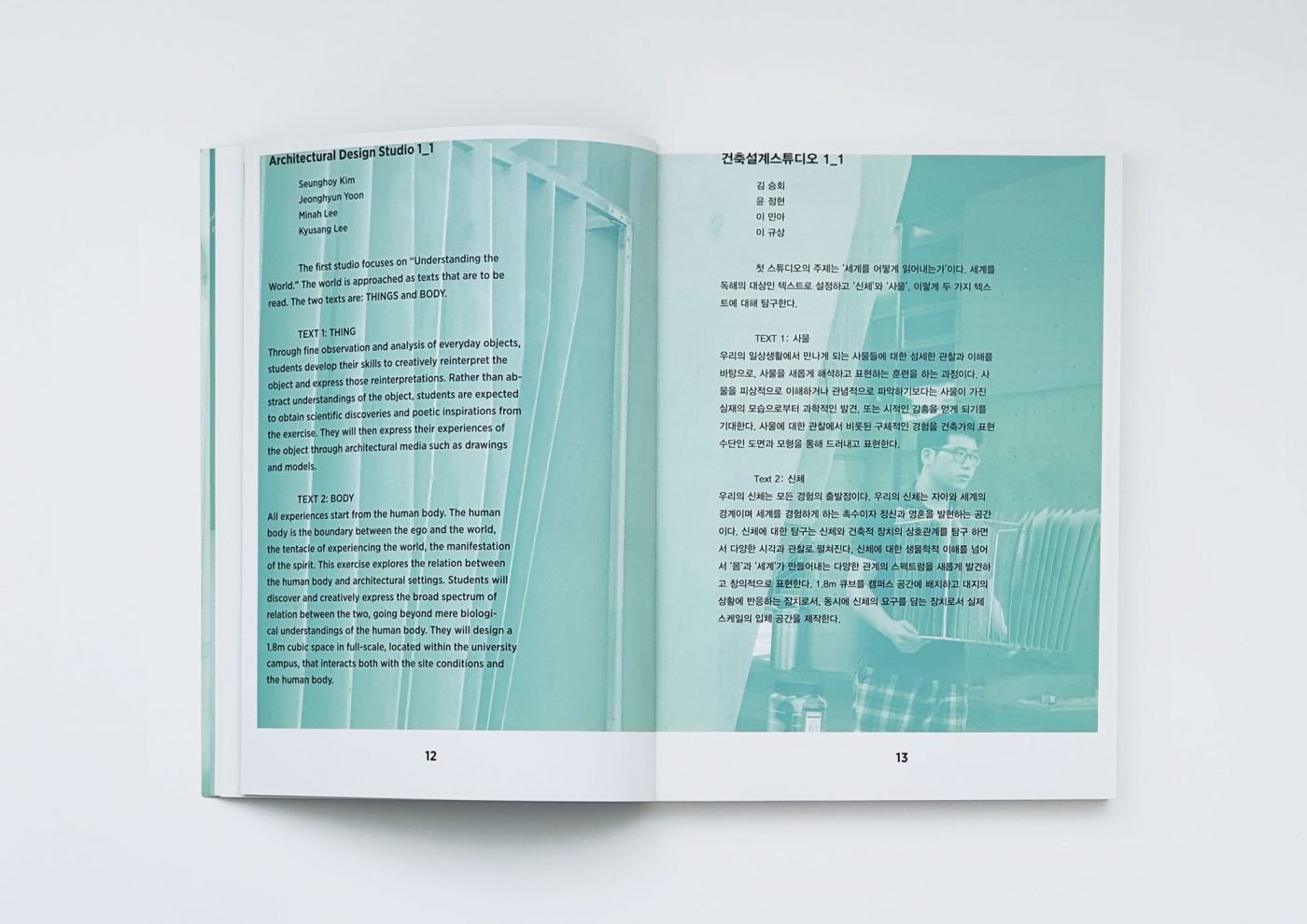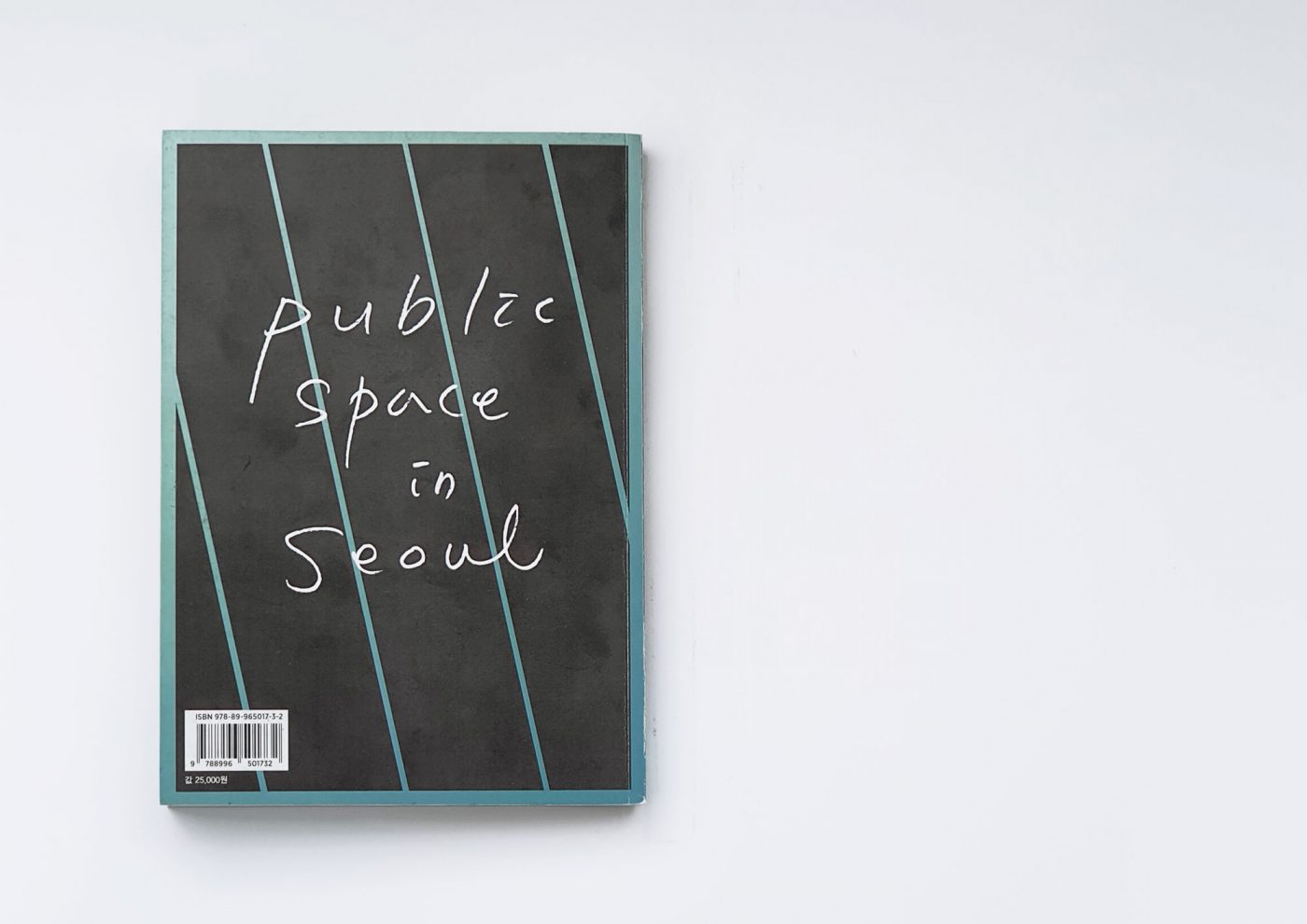SNU Architectural Review
2010 – 2011
2011, 1-1
건축설계스튜디오 1-1
세계를 어떻게 읽어내는가 : 신체, 사물
김승회, 윤정현, 이민아, 이규상
김기태, 박민정, 이희준, 정연중, 이상학, 강원기, 민세원, 장혜림, 강달현, 최복음, 전기원, 허경화, 고요한, 윤보람, 신기훈, 이신후, 김소영, 김미나, 남정훈, 이동주, 김근희, 박서완, 이민재, 김은혜, 이희준, 차현정, 허은석, 김영현, 박민정, 안기현, 최순범
첫 스튜디오의 주제는 ‘세계를 어떻게 읽어내는가’이다. 세계를 독해의 대상인 텍스트로 설정하고 ‘신체’와 ‘사물’ , 이렇게 두 가지 텍스트에 대해 탐구한다.
TEXT 1 : 사물
우리의 일상생활에서 만나게 되는 사물들에 대한 섬세한 관찰과 이해를 바탕으로, 사물을 새롭게 해석하고 표현하는 훈련을 하는 과정이다. 사물을 피상적으로 이해하거나 관념적으로 파악하기보다는 사물이 가진 실재의 모습으로부터 과학적인 발견, 또는 시적인 감흥을 얻게 되기를 기대한다. 사물에 대한 관찰에서 비롯된 구체적인 경험을 건축가의 표현 수단인 도면과 모형을 통해 드러내고 표현한다.
Text 2: 신체
우리의 신체는 모든 경험의 출발점이다. 우리의 신체는 자아와 세계의 경계이며 세계를 경험하게 하는 촉수이자 정신과 영혼을 발현하는 공간이다. 신체에 대한 탐구는 신체와 건축적 장치의 상호관계를 탐구 하면서 다양한 시각과 관찰로 펼쳐진다. 신체에 대한 생물학적 이해를 넘어서 '몸’과 ‘세계’가 만들어내는 다양한 관계의 스펙트럼을 새롭게 발견하고 창의적으로 표현한다. 1.8m 큐브를 캠퍼스 공간에 배치하고 대지의 상황에 반응하는 장치로서, 동시에 신체의 요구를 담는 장치로서 실제 스케일의 입체 공간을 제작한다.
The first studio focuses on "Understanding the World." The world is approached as texts that are to be read. The two texts are: THINGS and BODY.
TEXT 1: THING Through fine observation and analysis of everyday objects, students develop their skills to creatively reinterpret the object and express those reinterpretations. Rather than abstract understandings of the object, students are expected to obtain scientific discoveries and poetic inspirations from the exercise. They will then express their experiences of the object through architectural media such as drawings and models.
TEXT 2: BODY All experiences start from the human body. The human body is the boundary between the ego and the world, the tentacle of experiencing the world, the manifestation of the spirit. This exercise explores the relation between the human body and architectural settings. Students will discover and creatively express the broad spectrum of relation between the two, going beyond mere biological understandings of the human body. They will design a 1.8m cubic space in full-scale, located within the university campus, that interacts both with the site conditions and the human body.
2010, 1-2
건축설계스튜디오 1-2
도시탐구/ 이벤트공간
김승회, 김진균, 윤정현, 김성우
선지혜, 엄루비, 임하린, 황희진
1_1 스튜디오에서는 사물과 신체 그리고 텍스트에 대한 독해를 통해 세계를 이해하고 그것을 건축적 언어로 소통하고 상상하는 실험을 했다면, 1_2 스튜디오에서는 우리 삶의 배경이 되는 도시를 탐색하고 그 속에서 장소를 만들어내는 작업을 하게 된다. ‘세계에 대한 이해’ 라는 주제는 계속되지만, 우리 삶의 구체적인 일상에 보다 가깝게 접근하면서 우리 도시가 갖고 있는 다양한 시간과 공간을 체험하고자 한다. 서울의 두 개의 지역을 탐구하고 도시와 건축이 만나는 장소에 작은 공간을 제안한다. 주변의 도시적 맥락을 고려하고 사용자의 다양한 이벤트를 담는 공간을 제안한다. 건축적인 제안과 더불어 각각의 지역에 대한 답사와 탐구의 기록을 담은 보고서를 작성한다. 첫 번째 프로젝트는 도시공간에 대한 답사에 중점을 두는 반면에 두 번째 프로젝트는 ‘건축구조1' 수업과 공동으로 진행하면서 구조방식을 고려한 건축공간을 제안하는데 중점을 둔다.
If Architectural Design Studio 1_1 was an architectural experiment of reading the text of the world, this studio is an exploration of the city, the scene of our daily lives, and creation of meaningful places within the city. While the theme "Understanding the World" is maintained, students will move on to the more concrete time and spaces of our lives. They will analyze two areas of Seoul, proposing small-scale spaces where the city and architecture encounter each other. The urban context of the sites, the users' various events are to be considered. Apart from the architectural proposals, students are asked to dpcument their visits and analysis of the sites. The first proaect focuses on responding to the site, while the-second project focuses on, proposing a structurally soumd architectural space, being, run jointly with the lecture course 'Building Structures 1.'
2010, 2-2
건축설계스튜디오 2-2
building materials and structural systems.
최두남, 피터 페레토, 서 을호
경연성, 김환기, 김상, 소유정, 이예슬
이 과목은 설계를 진행함에 있어 공간 창출과 완성에 필요한 기술적인 측면에 대한 비중 있는 탐구를 통하여 재료에 대한 이해와 물성에 대한 감각을 높이며 건물이 구축되어지는 시공과정과 건물 구조 시스템에 대한 포괄적인 이해와 탐구가 이루어지도록 한다. 적절한 재료선택에 필요한 기본적인 건축적, 기술적인 지식을 바탕으로 다양한 구조시스템의 가능성 및 잠재성에 대한 개괄적인 이해가 이루어질 수 있도록 한다.
The objective of this course is to emphasize the importance of the technical aspect of architectural design by having students pay attention to building materials and structural systems. Students will have opportunities not only to examine the potential design possibilities of various structural systems but also to develop tectonic awareness of building materials.
2011, 3-1
건축설계스튜디오 3-1
도서관
김석현, 김석원, 이종수
경연성, 이예슬, Keonghoon Ko, Chanyi Park, 윤선경
단순 사용자 건물 혹은 단일 개체 설계를 습득한 학생에게 다중 사용자/다중개체 설계를 다룰 수 있도록 연습한다. 구조는 조적조나 노출콘크리트 벽식 구조에서 30mX30m범위에 6mX6m 라멘 그리드 반복구조로 확장하여, 중규모 공간에서 다양한 사용자가 이용하는 공간을 설계한다. 공공 홀과 책 저장 물류처리 공간이 갖추어진 도서관 프로그램에 대해 숙지하도록 한다. 특히 다중 이용 공간에서 새로이 유의해야 할 무장애시설 강사 초빙 강연을 개최하고 법규검토와 설계적용 연습을 실시한다. 기초 공간 연습 초반 1개월 동안은 공동스튜디오로 운영되며 그 후 3개의 스튜디오로 나누어 진행한다.
The 3rd year design studio focuses on moving on from single-use buildings to multiple-use buildings. Therefore, a repetitive 30 x 30m column-and-beam structure is introduced, with building programs for various users. Students will practice this concept through the design of a library, a synthesis of a public hall, book storage, and logistics. As a public building, the understanding of concepts such as 'barrier-free design' and 'universal access' is also very important. For the first month, studios are run jointly, focusing on spatial design, which are individually developed over the next three months.
2010, 3-2
건축설계스튜디오 3-2
특수전용공간설계
김현철, 김석원, 이종수
박승호, 황민
직전 학기에 연습한 다중이용 공간 설계에서 특수 전용 공간 설계를 다룬다. 구조는 단순 구조에서 복합구조로 확대 적용하도록 하고 중대규모의 다양한 사용자가 동시에 이용하는 관리시설과 특수설비 무대시설을 갖추고 관람객, 출연자, 관리자로 구성된 3원동선 체계를 다룬다. 이 과제에서는 도시꼴 연습을 통하여 다양한 건물군간 관계 짓기/건물군과 도시 콘텍스트사이 관계짓기 연습을 하고 배치계획과 특정한 형태를 통합하는 형태 디자인 능력을 기른다. 기능상으로 특수 건축물이 갖는 프로그램을 대해 숙지하고 다중이용시설에 적절한 무장애시설/ 안전 및 방재시설에 관해 이론적, 실천적으로 연습한다.
In this design studio, students practice the design of spaces for specialized uses. In doing so, they will work on performing theaters where a complex building structure is introduced having multiple layers of circulations: the audience, the actors, and the staff. Furthermore, site planning and form planning in response to the building clusters and urban context are explored. While the main focus is to understand the spatial program of a specialized use building,the concepts and implementations of 'barrier-free design,'universal access,' and 'fire safety' are also explored.
2011, 4-1
건축설계스튜디오 4-1
도시팽창에 반대하기
김진균, 김성우, 피터 페레토
이계현, 박승호, 박지형, 황민
서울은 끊임없이 변하고 있다. 오늘날에는 도시가 주변으로 지속적으로 팽창하고 있는 실정이며, 이 스튜디오에서는 이 현상이 불가피한 것인지, 다른 대안은 없는지를 질문하게 된다. 이를 위해 다음의 두 가지 사항을 고려한다. 보존: 1970년대의 아이콘이라 할 수 있는 세운상가 건물을 철거하는 대신 보존한 상태에서 건축적 제안을 한다. 반 도시팽창 : 오늘날 무분별한 도시팽창에 반하여, 기존의 건축물에 새로운 공공 용도를 삽입하여 남녀노소 구분 없이 도시민 모두의 삶의 중심이 될 수 있는 시설을 제안한다.
Seoul is constantly changing. The present change is a constant expansion of the city outwards towards the periphery. Is this condition inevitable or are there other models? In this studio we will seek to find a new model which considers two points: RRESERVATION : Retain and work with an existing building, Sewoon Sanga, an icon of the 1970s which will soon be demolished and replaced with a gener11c, glazed modern architecture that is inundating the world from Dubai to Phoenix via Hanoi. STOP THE SPRAWL : To present anoth r viable option to the sprawling city, we will seek to introduce a new public programme into the existing building as to make the building centre for people all around Seoul, from children to pensioners.
2010, 4-2
건축설계스튜디오 4-2
도시건축 : 도시설계를 구체화하기
김광현, 피터 페레토, 김태만
김우건, 문현식, 변희영, Jose Javier Gil Sebastian, 허지은, 김지우, 이지하, Marta Gil Perez, 표하림, 백수연, 김형주
건축설계는 점차 도시의 영역으로 확대되어 감에 따라고 도시의 영역을 구축하는 작업으로 변화하고 있다. 도시 안의 건축설계는 도시설계를 구체화하는 일이며, 실제의 사업 목표와 매우 밀접한 관계를 가지고 있다. 도시를 구성하는 대단지를 구성하는 데 참여하는 발주자의 요구와 시행의 현실적인 가능성, 새로이 조성되는 주거지에 상업적 활기를 불어넣기 위한 대규모 건축 프로젝트를 연습함으로써, 공공발주와 그에 따른 각종의 사업적 요구사항을 충족하기를 요구하는 오늘날의 개발사업을 이해하고, 건축가가 이러한 프로젝트에서 어떤 창의력과 설득력으로 도시공간을 새롭게 창조하는 건축물을 만들어낼 수 있는가를 탐구하도록 한다. 한편, 일부 학생은 도시를 전혀 다른 측면에서 접근하여, 현존하는 건물과 방, 공간과 이들의 조합으로 도시적 맥락에서 건축적 중재를 한다.
Architectural design is expanding its boundaries into urbanism. Codes and regulations that realize architectural design have changed, and architectural design is no longer about a separate building, it is a part of designing the city, the materialization of the abstract urban plan. By practicing urban-scale projects that involve various stakeholders, students understand how architectural design can creatively respond to the requirements set from a different discipline. Meanwhile, some students will look at the city rom a different stand point, embarking into am investigaion which looks at existing buildings, rooms and spaces and from the sum of these pluralities assembles a series of interventions which alone are isolated occurrences but collectively knit into the fabric of the city.
건축재료계획
건축공간과 재료의 관계
김승회
경연성, 송철호, 고경훈, 박성경, 윤선경, 윤여춘, 김상, 진민주, 이예슬, 조예린, 박찬이, 최민현, 한상후, 박다솔
건축가에게 있어서 재료는 건축의 요소로 이해되는 것이 아니라 건축 그 자체이다. 그러므로 재료는 설계의 마지막 단계에서 결정되는 것이 아니라 첫 단계에서부터 대지와 프로그램과 함께 총체적으로 다루어져야 한다. 재료계획의 수업을 통해서 재료의 성질과 그 사용 방식에 대해 이해한다. 그 이해를 바탕으로 재료와 관련된 건축디테일을 탐구하고 실제 건축공간과 재료의 관계를 살퍼본다. 한편으로 재료의 본질과 개념에 대한 숙고를 바탕으로 새로운 물질성에 대한 탐구가 이루어진다. 목재와 유리, 금속등 구체적은 재료로 오브제를 만드는 과정을 통해 재료와 물질에 대한 속성과 물성에 대한 독창적인 해석과 창의적인 표현을 실험한다. 이러한 재료에 대한 이해를 바탕으로 그것이 실제로 어떻게 건축물을 통해 구현되는지 구체적인 사례를 통해 탐색하고 재료에 관한 총체적인 이해와 전망을 습득한다.
For the architect, the material is not considered as the element of architecture; the material is architecture itself. So, the material has not to be decided at the last process, but handled at the beginning with site and program. Through this course, it would be studied that character of material and its usage, architectural detail that material needs, researching of new materiality. Understand the nature of material and usage of it. To aware of it, explore architectural details related to the material. Consider the relationship between architectural space in real scale and the materials. At the same time, research on physical make-up as new stood on the consideration about an essence and concepts of material. By making an object with specific materials like wood, glass, metal etc. experiment unique interpretation and creative presentation. Search the case how architecture is embodied, by understanding material, and learn the prospect and general understanding.
2010
졸업설계
졸업설계
강민지, 김수영, 위희정, 김예리, 소정은, 신세철, 박대전, 신현재, Paul Lee, 이승환, 정유리, 한보혁, 이준희, 정은석, 하숙경
졸업설계는 자신의 건축적 사고를 독자적으로 발전시키고, 이를 현실의 조건 위에서 구체적으로 실현하기 위한 작업이다. 이를 위해 수강지는 각자 현대도시를 분석하고그 현대도시가 우리의 일상생활에 어떤 경로를 거쳐 건축공간과 형태에 영향을 미치는지를 검토한다. 그리고 도시의 일각에 서게 될 대지에 주목하면서 대지에 얽힌 다양한 사람의 흐름, 물리적인 문맥, 자연환경에 대한 고려를 어떻게 설정하고 있는지를 건축적 어휘를 사용하여 구체화한다. 또한 자신이 설정한 프로그램을 논리적으로 해석하는 능력을 발전시켜 건축가라는 직업인으로서 앞으로 지속해야 할 자신의 가치를 발견하도록 한다. 더욱이 졸업설계에서는 건축디자인의 기초요소만이 아니라, 구조설비 등 기본적인 엔지니어링의 조건도 고려한다.
The graduatioon exhibition is a task to develop students' architectural thoughts in their own way and to realize the thoughts specifically in actual conditions. Students analyze modern cities and investigate how those cities affect to architectural spaces and shapes through what channel in our daily life. Furthermore, students embody their consideration for human flow, physical context and natural environment attending sites as the tip of the city. Students should develop their ability to analyze logically the program set up by themselves. That is the way to find their values that should be kept up as a professional architecture. The graduation exhibition reflects basic engineering conditions - structures, facilities and so on - as well as basic components of architectural design.
2011
졸업설계
건축의 공공성 : 건축은 무엇으로 이루어지는가
강은지, 김가영, 김우건, 김범정, 김지우, 김지원, 김형주, 민원홍, 문현식, 박세준, 양명석, 백수연, 박승진, 한유진, 유아람, 변희영, 유균형, 이석준, 이정한, 이지하, 최수훈, 한승은, 최종빈, 허병욱, 표하림, 박재현, 이문영, 이주현, 이진경, 이창빈, 정민선, 허지은, 이소영, 김지민, 손진호, 박정환, 이호준, 이슬비, 이두완, 김철구, 이동수, 홍민기, 원상현, 강기철, 조백현, 김수민, 안명진
건축의 공공성을 인식하는 것은 글로벌한 시대에 지역성을 형성하는 문제를 의식하는 것이다. 그렇게 하여 건축은 환경 안에서 사람을 함께 살도록 묶어주고 문화를 향유하게 하며 과거의 유산과 연결되어 역사를 창조한다. 또한 건축은 주변을 '건축으로 만들고 바꾸는 것'이다. 그렇다면 ‘건축이란 무엇인가’가 아니라, '건축은 무엇으로 이루어지는가'를 묻는 것이 중요하다. ‘건축’의 공공성이란 물체와 대지의 경계를 넘어 사회의 '가능성'을 열어주는 작업이다. 서울에서 건축의 공공성을 생각한다.
Awareness of the public nature of architecture is the key in the consciousness of locality in the global era. Architecture then brings the people to live together sharing a culture, and relates the people with their heritage of the past to create the new. In this sense, we must not question ourselves what Architecture is, but what Architecture consist of. Publicness in Architecture goes beyond built forms or the site boundary, opening 'Possibilities'of our society. Think of the publicness of Architecture in Seoul.
건축설계연구
공원와 도시의 경계면과 접합방식
최두남, 김현철
이원희, 윤해환, 이준구
도시는 삶의 축적과 소멸의 반복 사이에서 이루어지는 인간의 활동무대로서 도시인들 삶의 궤적은 물리적인(Physical) 또한 형이상학적(Metaphysical)인 도시의 실체에 의하여 지대한 영향을 받게 된다. 도시를 도시답게 만드는 요소들 중 도시 내에서 자연공간과 도시가 만드는 경계는 그 위치와 용도로 인하여 중요한 전략적인 가치를 지닌다. 도시 내에서 자연공간의 역할 및 활용이 중요한 화두가 되고 있는 시점에서 공원주변 경계면과 기존 도시와의 바람직한 접합을 통하여 잠재적인 가치를 극대화시키는 제안을 모색하도록 한다.
As a performance stage for human activity that accumulates and retracts in repetitive motion, the essence of the city, both in its physical and metaphysical sense, receives a great deal of influence from the deeds of the city dwellers. One of the essential elements that makes the city a city is in the intrinsic strategic value carried by the use and location of the boundary between nature and city. From the moment nature inside of a city becomes an important topic of architectural discourse, the goal of the studio is to guide the student toward a proposal that maximizes on the potentiality afforded by a sensible union between the greenery and the existing city conditions.
